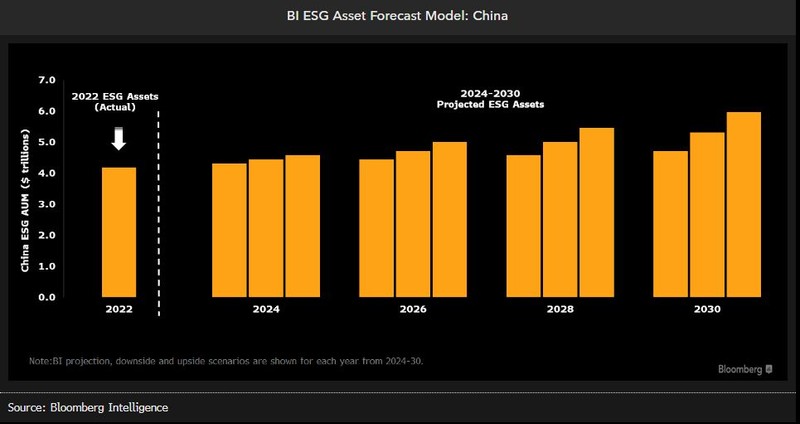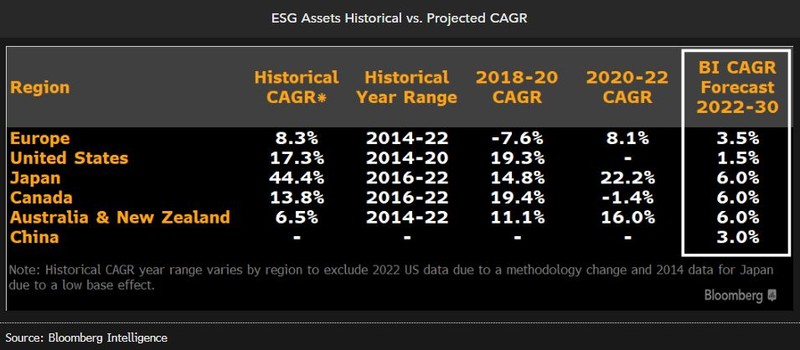This analysis is by Bloomberg Intelligence Director of Research Adeline Diab and ESG Analyst Rahul Mahtani. It appeared first on the Bloomberg Terminal.
The ESG market could surpass $40 trillion by 2030, based on our scenario analysis, anchoring the $140 trillion of projected assets under management (AUM) globally despite 70% slower growth and polarized sentiment. Scrutiny is critical as regulators tackle greenwashing, boosting market maturity and credibility but limiting product creation. Europe is set to remain the most significant contributor, while the US may stagnate amid the election and ESG backlash. Emerging themes and small yet expanding markets like Japan could support gains.
Our projections are based on BI’s ESG asset forecast model, which combines regional growth decomposition, historical trends and economic expectations, leveraging data from the Global Sustainable Investment Alliance’s (GSIA) 2022 report, where a methodology change halved US ESG AUM.
ESG assets to gain credibility despite slowing growth
ESG assets have proven resilient despite economic and regulatory uncertainty — reaching $30 trillion in 2022, according to the GSIA — and we expect them to surpass $40 trillion by 2030, with a CAGR of 3.5% as the market matures. That’s less than a third of the 12% pace set in 2016-20 amid a gold rush, greenwashing and misleading claims. Greater regulatory scrutiny and harmonization can bolster credibility but may also restrict product creation. Emerging themes and sustained demand could propel growth further, with the BI ESG Market Navigator suggesting that 85% of investors plan to increase their ESG AUM.
The 20% global decline in 2022 reflects the GSIA’s decision to exclude investments with vague ESG standards, halving the US’ total to $8 trillion. Europe rebounded to $14 trillion, while Japan surged 50% to $4 trillion.

Global 2030 allocation: Europe 45%, US 25%, Japan 15%
Europe will remain the largest ESG market, based on the BI scenario, with over $18 trillion of AUM in 2030, preserving its 45% global share. That assumes its CAGR will keep pace with the 3.5% global rate, albeit dipping from 8% in 2014-22. US CAGR could shrink to 1.5%, yielding $9.5 trillion of ESG assets by 2030. The upcoming presidential election, funds’ high market concentration and ESG backlash may push its share below 25%.
Japan, Canada and Australia are small but fast-growing markets, with the former climbing 50% to $4.3 trillion in 2020-22. Though these countries may continue to outstrip the global expansion, we expect their CAGRs to stabilize at 6% as regulation and mounting scrutiny drive market consolidation. Based on these assumptions, Japan’s share could exceed 15% by 2030, with nearly $7 trillion in assets.

China $5 trillion 2030 ESG AUM dominated by green loans
ESG AUM in China may surpass $5 trillion by 2030 vs. about $4 trillion in 2022, based on the BI scenario. That assumes a gradual increase, driven by the green loans market, which has dominated as state-owned enterprises embark on decarbonization plans. ESG funds in China — representing about $70 billion in 2023, based on GSIA data — comprise a small fraction of the assets but could gain importance after climbing more than 10x since 2008.
In our analysis, China is accounted for separately from the US, Europe, Japan, Canada and Australia/New Zealand due to the GSIA’s methodology and a lack of historical data.

BI ESG asset forecast model: The methodology
BI’s ESG asset forecast model delivers global and regional projections to 2030, leveraging data from the GSIA’s 2022 report. The model is developed in three stages. First, we analyze the historical growth trend in total ESG assets and the regional breakdown, providing insights into the expected CAGR during various stages of maturity in different markets. Second, we combine the historical information with our global and regional economic expectations and ESG views to derive each region’s estimated CAGR for the remainder of the decade. Finally, the CAGR projection for each region is scaled upward or downward to produce the upside and downside scenarios, respectively.

Growth revised lower vs. 2022 ESG asset forecast model
BI’s 2024 ESG asset forecast model was revised downward due to the more challenging global economic environment and market rationalization, with greater scrutiny demanding higher fund credibility. Our current calculation of $40 trillion by 2030 also reflects a change in the GSIA’s methodology, which reduced US assets by $8 trillion. After accounting for this decline, we have extended the previous model ($50 trillion by 2025) by five years to 2030 as market credibility trumps expansion.